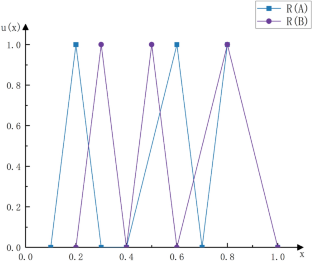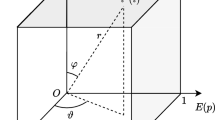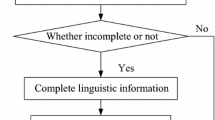Abstract
In practical decision-making, linguistic term set is a useful tool to describe the uncertainty and fuzziness of data sources. However, in some decisions, when the data source is unreliable or the decision involves future factors, the evaluation given by the linguistic term set will have a certain degree of error. This paper proposes a binary risk linguistic set based on linguistic term set and R-set. The binary risk linguistic set considers the linguistic term set and the risk factors that may lead to errors in language evaluation. In order to facilitate the use of binary risk linguistic set, the risk conversion function and operational laws are introduced. Next, since group decision-making involves multiple experts, considering the social relations between experts, a method to estimate the missing values in the social network matrix is proposed by utilizing the trust intensity propagation operator and the relationship intensity propagation operator. Risk perception can reflect the subjective judgment of experts on the characteristics and severity of a particular risk, and different judgment results can reflect the attitude of experts to risk. Hereby, this study proposes a risk clustering method based on the risk perception of experts. Furthermore, we propose an adaptive weight updating method based on social network matrix. Then, a binary risk linguistic fuzzy behavioral TOPSIS method is proposed to deal with the multi-attribute large-scale group decision-making (MALSGDM) problem. Finally, a case study is used to demonstrate the feasibility of the presented method, and its effectiveness is validated through comparison with other MALSGDM methods. To demonstrate the effectiveness of the proposed method, this study also perform sensitivity and stability assessments of the decision-makers’ weight and behavior characteristics.












Similar content being viewed by others
Data Availibility
Data sharing is not applicable to this article as no new data were created or analyzed in this study.
References
Zadeh, L.A.: The concept of a linguistic variable and its application to approximate reasoning-i. Inf. Sci. 8(3), 199–249 (1975)
Zadeh, L.A.: The concept of a linguistic variable and its application to approximate reasoning-ii. Inf. Sci. 8(4), 301–357 (1975)
Zadeh, L.A.: The concept of a linguistic variable and its application to approximate reasoning-iii. Inf. Sci. 9(1), 43–80 (1975)
Rodriguez, R., M., Martinez, L., Herrera, F.: Hesitant fuzzy linguistic term sets for decision making. IEEE Transactions on Fuzzy Systems: A Publication of the IEEE Neural Networks Council (2012)
Pang, Q., Wang, H., Xu, Z.: Probabilistic linguistic term sets in multi-attribute group decision making. Inf. Sci. 369, 128–143 (2016)
Liu, D., Huang, A.: Consensus reaching process for fuzzy behavioral topsis method with probabilistic linguistic q-rung orthopair fuzzy set based on correlation measure. Int. J. Intell. Syst. 35(3), 494–528 (2020)
Ishikiriyama, C.S., Miro, D., Gomes, C.F.S.G.: Text mining business intelligence: a small sample of what words can say. Procedia Comput. Sci. 55, 261–267 (2015)
Seiti, H., Hafezalkotob, A., Martínez, L.: R-numbers, a new risk modeling associated with fuzzy numbers and its application to decision making. Inf. Sci. 483, 206–231 (2019)
Seiti, H., Hafezalkotob, A., Martínez, L.: R-sets, comprehensive fuzzy sets risk modeling for risk-based information fusion and decision-making. IEEE Trans. Fuzzy Syst. 29(2), 385–399 (2019)
Wolfe, A.W.: Social network analysis: methods and applications. Am. Ethnol. 24(1), 219–220 (1997)
Brunelli, M., Fedrizzi, M., Fedrizzi, M.: Fuzzy m-ary adjacency relations in social network analysis: Optimization and consensus evaluation. Inf. Fusion 17, 36–45 (2014)
Dong, Y., Zha, Q., Zhang, H., Kou, G., Fujita, H., Chiclana, F., Herrera-Viedma, E.: Consensus reaching in social network group decision making: research paradigms and challenges. Knowl. Based Syst. 162, 3–13 (2018)
Wu, J., Chiclana, F., Fujita, H., Herrera-Viedma, E.: A visual interaction consensus model for social network group decision making with trust propagation. Knowl. Based Syst. 122, 39–50 (2017)
Liu, B., Zhou, Q., Ding, R.-X., Palomares, I., Herrera, F.: Large-scale group decision making model based on social network analysis: trust relationship-based conflict detection and elimination. Eur. J. Oper. Res. 275(2), 737–754 (2019)
Charnes, A., Cooper, W.W.: Management models and industrial applications of linear programming. Manag. Sci. 4(3), 274–275 (1957)
Hwang, C.L., Yoon, K.P.: Multiple Attribute Decision Making. Methods and Applications. A State-of- the-Art Survey. Springer, New York (1981)
Banayoun, R., Roy, B., Sussman, N.: Manual de reference du programme electre, note de synthese et formation 25. Direction Scientifique SEMA (1966)
Opricovic, S.: Multicriteria optimization of civil engineering systems. Fac. Civil Eng. Belgrade 2(1), 5–21 (1998)
Moslem, S.: A novel parsimonious best worst method for evaluating travel mode choice. IEEE Access 11, 16768–16773 (2023)
Dong, Y., Zha, Q., Zhang, H., Herrera, F.: Consensus reaching and strategic manipulation in group decision making with trust relationships. IEEE Trans. Syst. Man Cybernetics Syst. 51(10), 6304–6318 (2020)
Zha, Q., Liang, H., Kou, G., Dong, Y., Yu, S.: A feedback mechanism with bounded confidence- based optimization approach for consensus reaching in multiple attribute large-scale group decision-making. IEEE Trans. Comput. Soc. Syst. 6(5), 994–1006 (2019)
Wu, Z., Xu, J.: A consensus model for large-scale group decision making with hesitant fuzzy information and changeable clusters. Inf. Fusion 41, 217–231 (2018)
Xu, X.H., Du, Z.J., Chen, X.H., Cai, C.G.: Confidence consensus-based model for large-scale group decision making: a novel approach to managing non-cooperative behaviors. Inf. Sci. 477, 410–427 (2019)
Chu, J., Wang, Y., Liu, X., Liu, Y.: Social network community analysis based large-scale group decision making approach with incomplete fuzzy preference relations. Inf. Fusion 60, 98–120 (2020)
Xu, Y., Wei, G., Guo, W., Herrera-Viedma, E., Gong, Z.: Information consistent degree-based clustering method for large-cale group decision-making with linear uncertainty distributions information. Int. J. Intell. Syst. 37(6), 3394–3439 (2022)
Tian, J.Q.: Social network analysis-based consensus-supporting framework for large-scale group decision-making with incomplete interval type-2 fuzzy information. Inf. Sci. 502, 446–471 (2019)
Lu, Y., Xu, Y., Huang, J., Wei, J., Herrera-Viedma, E.: Social network clustering and consensus-based distrust behaviors management for large-scale group decision-making with incomplete hesitant fuzzy preference relations. Appl. Soft Comput. 117, 108373 (2022)
Xu, Z.: A method based on linguistic aggregation operators for group decision making with linguistic preference relations. Inf. Sci. 166(1–4), 19–30 (2004)
Hanneman, R.A., Riddle, M.: Introduction to Social Network Methods. Department of Sociology University of California, Riverside (2005)
Wang, J.Q., Wu, J.T., Wang, J., Zhang, H.Y., Chen, X.H.: Interval-valued hesitant fuzzy linguistic sets and their applications in multi-criteria decision-making problems. Inf. Sci. 288, 55–72 (2014)
Bao, G.Y., Lian, X.L., He, M., Wang, L.L.: Improved two-tuple linguistic representation model based on new linguistic evaluation scale. Control Decis. 25(5), 780–784 (2010)
Tversky, A., Kahneman, D.: Advances in prospect theory: cumulative representation of uncertainty. J. Risk Uncertain. 5, 297–323 (1992)
Scheid, M.P., Woodgett, J.R.: Protein kinases: six degrees of separation? Curr. Biol. 10(5), 191–194 (2000)
Lai, Y.J., Liu, T.Y., Hwang, C.L.: Topsis for modm. Eur. J. Oper. Res. 76(3), 486–500 (1994)
Chen, C.-T.: Extensions of the topsis for group decision-making under fuzzy environment. Fuzzy Sets Syst. 114(1), 1–9 (2000)
Alimoradi, A., Yussuf, R.M., Zulkifli, N.: A hybrid model for remanufacturing facility location problem in a closed-loop supply chain. Int. J. Sustain. Eng. 4(01), 16–23 (2011)
Pinochet, O.E.A.: Design a fuzzy-topsis (ftopsis) model in decision-making with multiple criteria for the implementation of telecommuting in a public higher education institute. Procedia Comput. Sci. 221, 426–433 (2023)
Liu, H.-C., Wang, L.-E., Li, Z., Hu, Y.-P.: Improving risk evaluation in fmea with cloud model and hierarchical topsis method. IEEE Trans. Fuzzy Syst. 27(1), 84–95 (2018)
Xuan, H., Liu, Q., Wang, L., Yang, L.: Decision-making on the selection of clean energy technology for green ships based on the rough set and topsis method. J. Mar. Sci. Eng. 10(5), 579 (2022)
Aydogan, E.K.: Performance measurement model for Turkish aviation firms using the rough-ahp and topsis methods under fuzzy environment. Expert Syst. Appl. 38(4), 3992–3998 (2011)
Joshi, R.: Multi-criteria decision-making based on bi-parametric exponential fuzzy information measures and weighted correlation coefficients. Granul. Comput. 1–14 (2021)
Silva, M.D.C., Gomes, C.F.S., Souza, R.C., Santos, M.D.: Topsis-2ne’s proposal. Int. J. Fuzzy Syst. 22, 1118–1122 (2020)
De Souza, L.P., Gomes, C.F., De Barros, A.P.: Implementation of new hybrid AHP-TOPSIS-2N method in sorting and prioritizing of an it CAPEX project portfolio. Int. J. Inf. Technol. Decis. Mak. 17(4), 977–1005 (2018)
Do, M., Silva, C., Francisco, C., Gomes, S., Junior, D.C.: A hybrid multicriteria methodology topsis-macbeth-2n applied in the ordering of technology transfer offices. Pesqui. Oper. 38(3), 413–419 (2018)
Yoon, K.P., Kim, W.K.: The behavioral topsis. Expert Syst. Appl. 89, 266–272 (2017)
Liu, P., Shen, M., Wu, X., Yu, L.: Probabilistic double hierarchy linguistic risk analysis based on failure mode and effects analysis and s-aras method. Inf. Sci. 648, 119608 (2023)
Zhu, J., Shuai, B., Li, G., Chin, K.S., Wang, R.: Failure mode and effect analysis using regret theory and promethee under linguistic neutrosophic context. J. Loss Prev. Process Ind. 64, 104048 (2020)
Wu, X., Liao, H., Zavadskas, E.K., Antuchevičienė, J.: A probabilistic linguistic vikor method to solve mcdm problems with inconsistent criteria for different alternatives. Technol. Econ. Dev. Econ. 28(2), 559–580 (2022)
Acknowledgements
This research is fully supported by Scientific Research Project of Hunan Provincial Education Department(21C0770).
Author information
Authors and Affiliations
Corresponding author
Ethics declarations
Conflict of interest
The authors state that they have no Conflict of interest in the paper’s publication. The authors declare no conflicts of interest.
Appendix A
Appendix A


Rights and permissions
Springer Nature or its licensor (e.g. a society or other partner) holds exclusive rights to this article under a publishing agreement with the author(s) or other rightsholder(s); author self-archiving of the accepted manuscript version of this article is solely governed by the terms of such publishing agreement and applicable law.
About this article
Cite this article
Huang, A., Yang, Y. & Liu, Y. A Binary Risk Linguistic Fuzzy Behavioral TOPSIS Model for Multi-attribute Large-Scale Group Decision-Making Based on Risk Preference Classification and Adaptive Weight Updating. Int. J. Fuzzy Syst. (2024). https://doi.org/10.1007/s40815-024-01710-6
Received:
Revised:
Accepted:
Published:
DOI: https://doi.org/10.1007/s40815-024-01710-6




